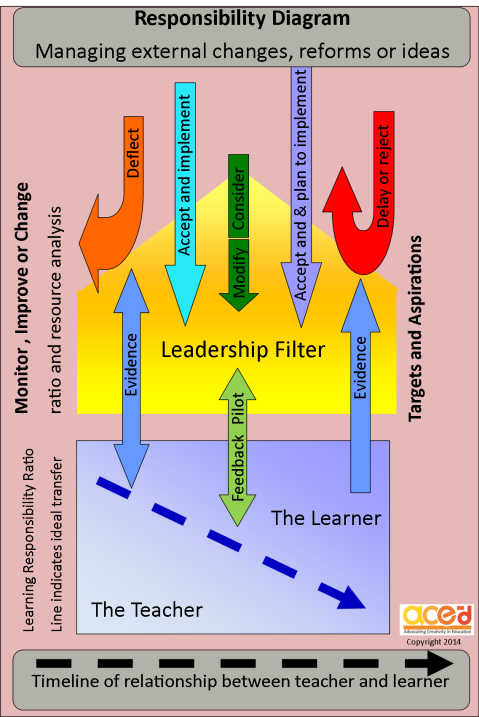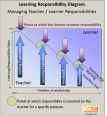The Return to School
The original post below was written THREE FOUR years ago now. Has anything changed?
It’s not exactly easy re-reading an article you wrote some time ago and finding that it’s still so relevant to education in the UK. Hope appears to takes a bit of a bashing when this is the case. So here is my hope once again and what I see as the responsibility of school leadership to make it happen.
The leadership mantra
“If whatever change comes along supports or enhances the relationship you have with your students and will improve your teaching and their learning then make it your own.
If on the other hand it will erode or fracture your relationships with the students you teach and thereby make teaching and learning harder than it is then find ways to either deflect the change or modify it in a way that causes no harm.”
The original article, see how many things have changed since 2014
“All Change – or is it?”
Here in the UK a new term is about to begin and we have new direction from Ofsted in the form of revised guidance and a new Secretary of State for Education. Some teachers will be joining new schools and many will be facing the challenges of getting to know and teach new classes. Some teachers may even be taking on new challenges in the way of responsibilities or even the subjects and syllabi they will be teaching. The school may be facing new challenges or targets and there may even be new leadership intent on bringing about improvements. A new timetable always brings with it a certain level of stress too as teachers and students try to remember where they should be and when and with what. A timetable can have a significant impact on the quality of teaching and learning and when the “tail wags the dog” instead of enabling as the timetable can sometimes do many pay the price during the year. You would be forgiven for being overwhelmed even before you sit and listen to the Head setting out the challenges and goals for the year ahead.
The principles on which teaching is based
Luckily there are the routines and traditions that can form the refuge for the bewildered and confused and these can be found in the classrooms, corridors, and playgrounds of the many schools facing the new term. There will be a desk and seat, a teacher, a focal point, a register to call, rules to follow, expectations and things to learn. These are the everyday realities of teaching and even with interactive whiteboards, improved planning rubrics, simpler assessment systems, computers and tablets, 3-D spaces and the odd new pencil case, little if anything really changes when it comes to the actual job of teaching.
It’s not all about resources
I have seen some of the best teaching with the most basic of resources and simplest of systems and some of the poorest teaching with the most sophisticated of resources and most intricate of systems. I have also seen some of the best teaching with the least motivated of learners and some of the poorest teaching with those learners so eager to conform and please.
If you are now expecting me to call for a back to basics approach or to ignore change because we have all seen it before and no doubt it will come around again then I must disappoint you.
Neither am I advocating that you jump in with both feet and take on board whatever change you face with as much enthusiasm you can muster. What I am reminding you of is the importance of building the firm foundations that will allow you to teach and then I am asking you to consider everything else in light of this one responsibility and this is it:
If whatever change comes along supports or enhances the relationship you have with your students and will improve your teaching and their learning then make it your own.
If on the other hand it will erode or fracture your relationships with the students you teach and thereby make teaching and learning harder than it is then find ways to either deflect the change or modify it in a way that causes no harm.
In my view it is the role of the leadership team to ensure that the learning environment and the relationships between teacher and learner are protected at all times and from all directions.
Leadership responsibilities and change, reform and new ideas
Below is a diagrammatic representation of what I see as the principle role of leadership in this respect. There is a lot to take in in one go but focus on the learning responsibility ratio (the rectangle shaded blue at the bottom) which, if protected, should naturally over time move from an emphasis on the teacher to prepare, plan, motivate, engage and encourage to the learner taking more responsibility for managing the learning environment to meet their own needs. This transition has a great deal to do with “Learning Intelligence” and “Learning Needs”* (not learning styles). Although I have not shown what happens when the leadership fails to protect this relationship in effect the responsibility reverts to the teacher and we end up with a “saw tooth” rather than a straight line transfer. In extreme cases the learner may abdicate all responsibility for learning since any immediate consequences fall on the teacher and not the student.
If you would like to explore the Teacher Learner Relationship then please see this article.
If we accept that it is the teacher’s responsibility to manage the learning environment then here are my four foundation stones for teaching.
Learning Needs
There are “Learning Needs” and we all have them. When planning lessons make sure you include these four headings. The 4 learning needs are based on 35 years of teaching experience but the headings come from William Glasser [i] Its an easy set to remember – just Please Be Child Friendly in your approach and planning!
1) Power – how will I give my students a voice and show them that I am listening to their concerns and needs?
2) Belonging – what can I do to build a sense of belonging as I develop my relationships with my students in a way that builds trust and loyalty?
3) Choice – what choices will I allow and how will I link these to consequences? How can I show them that they can have some control over their learning environment and that in doing so they can make learning easier?
4) Fun – how will I build the link between fun and achievement and how will I ensure we celebrate success to make learning fun?

* Want to know how you can develop this model in your organisation or find out more about how LQ can improve the performance of your students?
* For more on the school learning environment see an earlier article “The First LQ Topic Review – LQ and the School Environment”
I can be contacted by phone at 01604 891229 or 07519743941
By e-mail at kevin@ace-d.co.uk
Through Skype: ace-d.co.uk
* For an alternative way to explore planning through what I call “Learning Intelligence” then see the article “Learning Intelligence (LQ) and Lesson Planning” at: http://wp.me/p2LphS-a6
For an introduction to Learning Intelligence then see: http://wp.me/p2LphS-3p and a graphic covering the skills, attitudes, attributes and behaviours at: https://magic.piktochart.com/output/2297869-learning-intelligence
For a detailed exploration of learning needs I have published an e-book “Understanding Learning Needs” available for download at: http://www.ace-d.co.uk/id10.html Priced at £4.95. This book has been recognised by experienced professionals as an excellent reminder of the important things in teaching and learning and by those mentoring and guiding new teachers as sound advice and guidance for a successful career.
[i] William Glasser (2001) Choice Theory in the Classroom, Harper



If the changes do occur, are they purely on the student side, OR are all teachers partially or totally autistic with OCD tendencies, so that change is not forthcoming easily?
LikeLike
Interesting observation about about teachers. No – I think most teachers were compliant and successful learners within the traditional school environment and because we have a tenancy to be where we are comfortable they return to the classroom as teachers. This makes change difficult because the teacher has to change first!
LikeLiked by 1 person